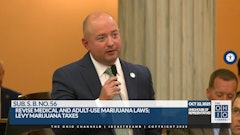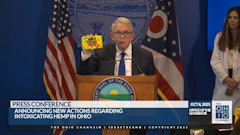
Skimming the United States Department of Agriculture’s (USDA) final rule on hemp, one might be remiss to think that variations of the word “tribe” only appear near the words “state” and “states”—and nowhere else. However, in numerous instances, the rule deviates from this parallel structure, revealing a clearer image of the rules and regulations that are expected to shape the market on Native American lands.
In an email interview with Hemp Grower, Aaron Fournier, J.D., chief operating officer of Native American Hemp, a company that grows and processes hemp as well as consults tribes and Indigenous-owned hemp businesses, shared insights on the final rule from himself and Gregory Guedel, Ph.D., J.D., Native American Hemp’s executive director.
Fournier, a member of the Chickasaw Nation, whose operation grows hemp outside and indoors in multiple locations including on both the East and West coasts, said the final rule includes developments that will benefit Native American tribes. “The new regulations provide helpful clarity on key points tribes need to consider in their hemp enterprises, such as how to establish an appropriate regulatory framework and enforcement mechanisms for hemp operations in tribal jurisdictions,” he said.
As HG previously reported, the final rule expanded the window of time that crops must be sampled before harvest from 15 days to 30. It also increased the tetrahydrocannabinol (THC) negligence standard in testing from 0.5% to 1% THC and delayed the requirement that testing labs must be registered with the U.S. Drug Enforcement Administration (DEA) until 2022.
“The additional flexibility is an appropriate recognition of the realities tribes face on the ground—the hemp industry is still in its (second) infancy in America and not all systems and procedures are yet in place in all locations,” Fournier said. “Removing punitive penalties and unrealistic testing timelines will help encourage more tribes to explore opportunities with hemp production, which is a positive dynamic for the whole industry.”
Fournier discussed the following topics with HG.
Tribal Jurisdiction Over Hemp
The final rule states that “Upon USDA approval of a Tribal plan, an Indian Tribe may exercise jurisdiction and therefore primary regulatory authority over all production of hemp in its Territory regardless of the extent of its inherent regulatory authority.”
Fournier explained: “Under federal law, tribes have jurisdiction in their lands over matters that Congress has not claimed for exclusive federal jurisdiction. The final rule clarifies that tribes do in fact have the ability to assume full jurisdiction over hemp operations in their lands, which is very important for avoiding costly and time-consuming legal questions on which laws apply and who can enforce them.”
The final rule states that it “expands the definition of ‘law enforcement’ to include Tribal law enforcement.” This is a win for tribes, said Fournier, noting that they will have enforcement authority over federal laws that apply to territories.
“By authorizing direct legal enforcement by tribes, they can now take timely and effective action to ensure hemp operations within their lands are operating in compliance with applicable requirements, and they can exert their inherent sovereignty over this rapidly expanding industry to ensure it develops in harmony with tribal laws and procedures,” he said.

Disposal of Non-Compliant Plant Material
The final rule states that growers have multiple options to remediate a non-compliant test result, “either disposing of flower materials and salvaging the remainder of the plant or blending the entire plant into biomass plant material. Through both forms of remediation, the farmer may be able to minimize losses and, in some case, produce a return on investment.”
“These developments are new and very helpful for tribes,” Fournier said. “In many states, a crop that inadvertently proved to have excessive THC levels was required by law to be completely destroyed, with no beneficial uses allowed. The new rule recognizes the inherent unpredictability of nature and ends the wasting of hemp biomass that literally has thousands of uses beyond human consumption.”
Prior to the issuance of the final rule, commenters shared with the USDA that regulations surrounding disposal should honor the cultural beliefs of tribal members. In the rule, the agency states, "... [A] comment from an Indian Tribe noted that requiring crop destruction is culturally offensive to indigenous people that traditionally use every part of every animal and plant that can be utilized."
The concern rings true across numerous tribes, Fournier said. “The cultural approach to agriculture and plant use among tribes is varied and reflects their unique histories and values, but in general, it is a priority for Indigenous communities to live and work harmoniously with nature and not waste any of nature’s gifts,” he said. “Growing a useful crop and then having to just burn it due to a testing anomaly is obviously wasteful and inconsistent with being good stewards of our planet, and having the ability to use a non-consumable crop for other beneficial activities is a more culturally appropriate approach.”
Fournier said Native American Hemp’s experience and partners allow for conversion of raw hemp for thousands of uses, including, sustainability-wise, hempcrete that absorbs carbon.
In addition, he said, “For each of our growing locations throughout the United States, we establish a local facility to help reduce transportation costs and related carbon emissions for processing the crop, and we offer access to local farmers to help increase the efficiency of their hemp enterprises.”
Indigenous Collaboration with USDA
The final rule outlines several more ways USDA has worked and plans to continue to work with Native Americans in the hemp space.
According to the final rule, for example, “A comment contended that the requirement for a geospatial site identification … is too expensive for Indian Tribes, unnecessary, and not readily available. Comments said the Department of the Interior has land records that could be used to obtain necessary information.”
USDA’s response states that geospatial identification is one way to provide a legal description of land as required in the Agriculture Improvement Act of 2018 (2018 Farm Bill). It continues: “Producers are required to provide information to FSA [Farm Service Agency] on the geographical location of hemp production. FSA offices will provide assistance in identifying such location at no cost to producers.”
“Tribes have widely varying capabilities for land identification based on numerous factors, and making land boundary identification as simple and inexpensive as possible is a very positive catalyst for developing the industry in tribal areas,” Fournier said. “The FSA has always worked with tribes on the development of agricultural programs, and the FSA’s now-explicit offer to help with land identification for hemp agriculture is helpful and will likely be appreciated by many tribes particularly in rural areas.”
In addition, the final rule relayed that a commenter suggested the USDA “hire an Indian law expert to assist with development of the final rule.” The final rule includes the response that “USDA agreed and hired a consultant with 40 years-experience as an Indian law attorney to assist with the development of the final regulations and the review of Tribal plans.”
Expressing the importance of Native American representation in the rulemaking process, Fournier said, “Tribes operate within unique political, legal, and economic circumstances that are very different from non-tribal farmers operating on standard fee-simple land. In order to produce rules that will actually help develop agriculture in tribal communities, that context has to be incorporated into the process and regulations, and it is gratifying to see the USDA’s efforts to do that.
“As a result, the new rules reflect a level of tribal-centric competence that is at the top of the scale for federal regulations, and the USDA’s process and final rules provide a good model for other federal agencies to use for appropriate tribal engagement.”

























